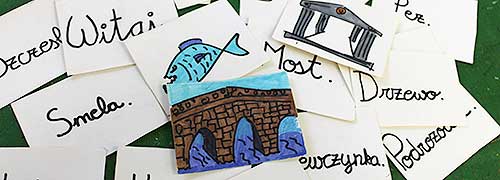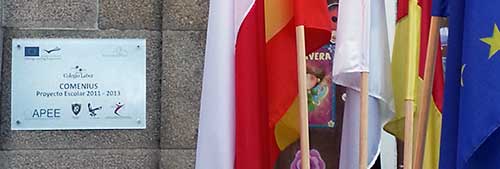
Colegio Labor Vigo
www.colegiolabor.com

Colegio Labor Vigo
www.colegiolabor.com

KGS Altentreptow
www.kgs-altentreptow.de

Jõhvi Gümnasium
www.johvig.edu.ee

Gymnazjum 11 Koszalin
www.jedenastkakoszalin.pl




El principal objetivo de los cuatro colegios participantes era el de diseñar y utilizar técnicas modernas de enseñanza-aprendizaje para que las clases resultasen más interesantes, atractivas y estimulantes para los alumnos. Dichos métodos supondrían una ayuda adicional a los profesores para combatir el aburrimiento y el absentismo en las aulas y elevar el nivel de motivación entre el alumnado.
En su momento, consideramos que nadie mejor que nuestros propios alumnos para poner en práctica este objetivo: la idea era que ellos mismos se enseñasen unos a otros contenidos y competencias.
Se trabajaron temas relacionados con la geografía, las ciencias naturales, la música y los deportes. Ya que el inglés se utilizó como vehículo para impartir contenidos, supuso, sin duda, la lengua que más se practicó, sin embargo, se acordó que, igualmente, se impartirían ciertas nociones de al menos dos de las cuatro lenguas nativas de los colegios participantes.
Además, la atención se centró en la competencia individual de nuestros alumnos: como ejemplo, ellos mismos propiciaron ocasiones para enseñar contenidos los unos a los otros. Los profesores, por otra parte, actuaron como moderadores asesorando a los alumnos.
Lo más destacado del proyecto fueron las llamadas Semanas Europeas: los alumnos de todos los colegios participantes pasaron una semana en cada uno de los colegios adheridos al programa; allí desarrollaron un trabajo cooperativo, presentaron los resultados del mismo y evaluaron su trabajo. Estas jornadas supusieron un encuentro intercultural donde la música o los deportes aseguraron la diversión para todos los miembros de los distintos países.
The main aim of all participating schools is to enrich lessons at school by using more attractive and modern means and methods of teaching and making it more interesting and challenging for our learners. The students of our schools would be highly motivated and it could be an additional help to fight boredom in lessons and truancy.
How shall that work? Well, nobody knows better than our students themselves. That’s why active learning and teaching methods is put in the center of this project. The idea is that students teach each other subjects and competences.
Topics will be taken from geography, natural sciences, music and sports. Since English as a foreign language will be the main tool of imparting knowledge it will be used and improved most, but it is agreed that at least 2 native languages of the partner schools will be taught at each school to a certain degree.
Furthermore the self-competence of our students will be put into the center of attention, i.e. students will organize opportunities to teach topics to each other. Teachers will stand aside as counselors and moderators.
The highlight of the project work will be a kind of European week at each school where students of all participating institutions are asked to work together, show results and evaluate their work. This meeting shall be understood as an intercultural coming together with music and sports and fun for all members of the delegations.


Grabación en cuatro videos de las diversas actividades desarrolladas durante las cuatro semanas europeas: Alemania (28-01-12), Estonia (14-04-12), Polonia (22-09-12), España (06-04-13). También elaboraron presentaciones de cada una de las semanas Europeas que fueron expuestas a padres y demás compañeros. Para ello utilizaron power point como apoyo de la presentación. Alemania (28-01-12), Estonia (14-04-12), Polonia (22-09-12 / 09-02-13), España (06-04-13).
The activities carried out during the four European weeks were recorded on four video clips: Germany ( 28-01-12 ), Estonia ( 4/14/12 ) , Poland ( 22.09.12 ) , Spain ( 13/04/06 ) . They also prepared power point presentations on each of the European weeks to later show to parents and other schoolmates: Germany ( 28-01-12 ), Estonia ( 4/14/12 ) , Poland ( 22.09.12 / 2.13.09 ) , Spain ( 13.04.06 ) .



Trabajos de Ciencias Sociales


Carné Comenius/ Comenius Idnetity Card (PDF)Carné identificativo con los datos de cada alumno y símbolos del proyecto.Each student had a card including their personal details and Comenius project’s symbols.